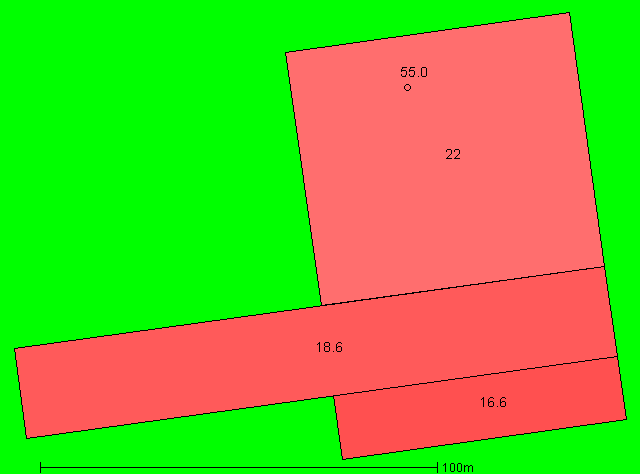
This page should be read in conjunction with How Plume Plotter Works. It provides more details specific to the Derby version of Plume Plotter.
Building measurements are taken from [1].
This image shows the layout of the stack and buildings modelled. (North is at the top; numbers indicate the height of stacks and buildings; lighter shades of pink are used for higher buildings.)

All of these are taken from [2] except the stack location which is not stated, so it was estimated from an aerial photograph:
The following values are used for albedo, Bowen ratio and roughness length. Roughness length 0.5m was specified in [1] but we use a different source of weather data:
The emission rates of pollutants are taken from [2], except the emission rate of oxides of nitrogen, which is the (lower) annual average imposed by [4]. The emission rates are:
| Pollutant | Emission rate per second |
|---|---|
| Oxides of nitrogen | 3.379 g |
| Particulates | 321.8 mg |
| TOC | 321.8 mg |
| Carbon monoxide | 1.609 g |
| Sulphur dioxide | 1.609 g |
| Hydrogen chloride | 321.8 mg |
| Hydrogen flouride | 32.18 mg |
| Mercury | 1.609 mg |
| Cadmium and thallium | 1.609 mg |
| Other metals | 16.09 mg |
| Dioxins and furans | 3.218 ng |
| Ammonia | 160.9 mg |
| Nitrous Oxide | 965.4 mg |
| Benzo(a)pyrene | 32.18 μg |
| PCBs | 160.9 μg |
| PAHs | 321.8 μg |
The background levels of pollutants are taken from [3]. These are:
| Pollutant | Background concentration per m3 |
|---|---|
| Oxides of nitrogen | 26.4 μg |
| Particulates | 23.2 μg |
| TOC | N/A |
| Carbon monoxide | 170 μg |
| Sulphur dioxide | 6.15 μg |
| Hydrogen chloride | 550 ng |
| Hydrogen flouride | 2.46 μg |
| Mercury | 80 pg |
| Cadmium and thallium | 330 pg |
| Other metals | 72.11 ng |
| Dioxins and furans | 52 fg |
| Ammonia | 6.3 μg |
| Nitrous Oxide | N/A |
| Benzo(a)pyrene | 206 pg |
| PCBs | 385 pg |
| PAHs | 31.5 ng |
Weather data is taken from METAR reports from a local airport: East Midlands.
Upper air data is from the Nottingham upper air station or, if not available, the upper air station. The sounding used is the 0:00 UTC sounding from the same day. For example, the sounding dated 0:00 (UTC) June 1 is used throughout June 1 (UTC). This is as recommended by the AERMET/AERMOD instructions.